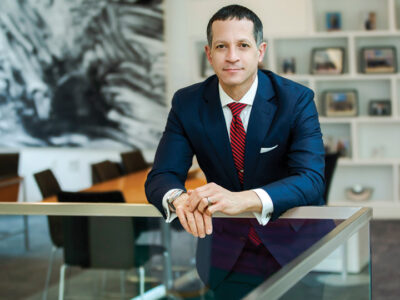IN recent years, the question of “Who is a Jew?” has plagued Israeli Jews, as Orthodox rabbis have attempted to deny the legitimacy of Reform and Conservative Judaism. But according to Dr. Ian Lustick, professor and chair of political science, the question takes on a whole new dimension when one looks at the recent waves of immigrants to Israel from the former Soviet Union.
Though the silence on the subject has been deafening, he says, most new arrivals to Israel are not Jews “by virtually anyone’s definition” of the word. And the implications for Israeli society — and the local Arab population — are profound.
The current conundrum began innocently enough in 1970, when Israel amended its Law of Return to allow non-Jewish relatives of Jewish immigrants into the country as citizens. The rationale, says Lustick, “was a humanitarian one — the reunification of families.” But the world was a different place then. Nobody imagined that hundreds of thousands of immigrants would be arriving each year from Russia and the other former Soviet republics. As a result, he says, by defining as a “relative” anyone with a Jewish grandparent, an increasingly large proportion of those immigrants have turned out to be gentiles.
“Millions of people in the former Soviet Union can present themselves as eligible because, through intermarriage, they have one, probably dead, grandparent who had a Jewish mother,” says Lustick. “And all of these folks, whether they ever saw the inside of a synagogue or ever thought of themselves as Jewish — or whether they’re in fact proud to be Christian — are legally entitled to all the benefits of immigration status in Israel.”
Since 1989, at least 300,000 of the roughly 750,000 new immigrants from the former Soviet Union have not been considered Jewish by themselves or anybody else, notes Lustick, who presented his findings at the annual meeting of the American Political Science Association last September in a paper titled “Israel as a ‘Non-Arab’ State: The Political Implications of Mass Immigrations of Non-Jews.”
In recent years, he adds, even official annual statistics show “clear majorities who are gentiles.” That does not take into account the “very substantial” number of immigrants who entered the country with forged documents or whose credentials as Jews could be disputed under Israel’s strict rules for determining Jewishness. Given that the Soviet and post-Soviet immigrants now amount to nearly 20 percent of Israeli citizens, he says, Israel’s dominant majority is already “better described not as ‘Jewish’ but as ‘non-Arab.'”
Strangely enough, both the Left and the Right — for very different reasons — are tacitly supporting that situation, or at least making no effort to change the Law of Return. The Right, says Lustick, resists any tinkering with the law because it views such actions as “emblematic of a post-Zionist rejection of Israel’s Zionist vocation.” Furthermore, in the early 1990s, the right-wing government of Yitzhak Shamir (who once justified his opposition to territorial compromise by proclaiming that “big immigration requires Israel be big as well”), was “so enthusiastic about the fact that these were not Arabs that they didn’t care that much whether they were Jewish.”
Meanwhile, notes Lustick, the “seculars on the Left” have viewed any changes to the law that might tighten up the definition of Jewishness as “playing into the hands of the ultra-Orthodox rabbis,” whom the Left criticizes as racist for using stringent, blood-linked criteria.
There is another element at work: the sizeable bureaucracy whose very existence depends on finding and helping potential immigrants in the former Soviet Union to immigrate to Israel. Given the very attractive benefits of immigrant status in Israel, especially compared to the economically distressed former Soviet Union, it is no surprise that the bureaucracy continues to find eligible candidates.
In addition, there are the hundreds of thousands of “guest workers” who were brought in during the intifada from places like the Philippines, Romania, South America, and Thailand to perform the jobs that the Palestinians weren’t taking. They never left, and while they may not be citizens yet, they do live in Israel.
“The face of the country is changing dramatically,” says Lustick. “When the census was taken in 1995, they did not ask anymore: ‘Are you Jewish?’ ‘Are you Christian?’ ‘What is your ethnic national background?'” It wasn’t just that the census-takers could not agree on what they would consider a truthful answer; it was also “too sensitive to report just how many people were not Jewish in the country — but who were being counted in a majority that was not Arab.”
And when it comes to polling on such sensitive issues as withdrawal from the West Bank or the creation of a Palestinian state, the numbers are getting seriously skewed. Because of the significant proportion of non-Arab non-Jews in polling surveys, one leading Israeli pollster told Lustick that the “Jewish majorities” who were sometimes reported as being in favor of one option or another were not really “Jewish majorities” but “non-Arab majorities.” But, the pollster added, if he were to spell that out publicly, he “would have to seek political asylum in the United States.”
“When I share this work with other people, even well-informed observers, their jaws drop,” says Lustick, who notes that the few politicians who have dared raise the issue have been “shouted down, ignored, or told that this is not an issue which ought to be discussed publicly.”
But the problem is not going away quietly, and since conversion to Judaism under Israel’s Orthodox establishment is now a “very long, arduous, and selective process,” as Lustick notes, another approach has been advanced by some of the more “fundamentalist and ultranationalist Jewish groups.” It involves a one-time “mass-conversion ceremony” — one that could, “in one fell swoop, turn hundreds of thousands of non-Jewish immigrants into Jews.” It would be “followed by a tight closing of the door to more such arrivals.”
Israel’s current confusion is hardly unique, points out Lustick: “There’s always been a debate in every nationalist movement over whether national identity is an unchangeable essence, or whether membership in the national community can expand or contract depending on opportunities and circumstances.”
A more interesting way of looking at the current situation, he argues, “is that Zionism is an ideology, and like all successful ideologies it contains some answers to people’s problems for a particular period. And for the crisis of European Jewry, especially in the late 19th and first half of the 20th century, Zionism really was a brilliant answer to the Jewish problem — even if it was not a very convenient answer for Arabs.”
But the world changes faster than ideologies change, and an ideology such as Zionism — the product of a particular place and time — will inevitably lag behind the changing world around it. As a result, he says, “it’s not surprising that life, which is organic and bubbling, can find ways to manipulate these old ideologies for its own purposes.”
Wednesday, July 9, 2025
Popular
Administration
Anniversary
Archaeology
Architecture
Art
Awards
Books
Calendar
Campus Life
Commencement
Education
Elsewhere
entrepreneurs
Events
Exhibition
Expert Opinion
Faculty
Film
Football
Gifts
Health
Healthcare
Heard on Campus
History
International
Leadership
Medicine
Men's Basketball
Music
notes
obits
painting
Penn Medicine
Penn Museum
Philadelphia
Photography
Poetry
Politics
Science
Student Life
Technology
Television
Theater
Wharton
Window




